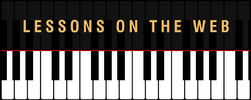|
Transposition is where we transport music from one key to another. We play the same tune, but with different notes. In other words, we could take a simple example like the five-finger pattern where we play C, D, E, F, and G. This is in the key of C so we start on C but to transpose it to the key of G, so we’re going to start on G this time, instead of C. Now we play G, A, B, C, and D.
It’s very important to remember to play the notes in the new key signature because we want to maintain the same distance relationships between notes. The relationship between two notes right next to each other is defined as being either a whole step or a half step. A whole step is made up of two ½ steps, whereas the ½ step just has the one in it. If we use our original five-note exercise and analyze the relationship between each of the notes we end up with the following pattern: Starting with the first note C and moving to the next note, and so on through each of the notes - Whole step, whole step, half step & whole step. Now, if we move to the note D and start there instead of C…we would play the notes D, E, F#, G, & A. Because of the F#...the relationship between the notes mirrors the same patterns as when we started on C…and this is what we want. This is what makes it ‘sound the same’ so to say, instead of completely differently as if we were moving into a minor mode. We can see this same repeated pattern in scales. Consider major scales as just one example. All major scales have ½ steps between the 3rd and 4th notes, and the 7th and 8th notes. Even if you didn’t know your key signatures or had never played a specific scale beforehand, all you need to know is where you need to have whole steps and half steps in order to play any major scale. When you transpose something and start playing it and it doesn’t sound the same as the previous key, it probably means that you are missing one of the new key signature notes – a sharp or flat; so make sure to listen carefully. To start transposing on your own, begin playing through the five-finger exercise mentioned above starting on as many different notes as you feel comfortable with. Again, make sure to include the new sharps or flats each time you move to a new note. Next, take a very simple (for you) piece – play through it one time in the original key signature, and then move it to another easy key signature, say maybe with one more sharp, and play it through in that new key with the new corresponding sharps or flats. Make sure that your half steps and whole steps mirror the original key. If you run into any difficulties, make sure to watch the following video as I go over the five-finger samples as well as two other easy pieces that I transpose at the keyboard so you can see how I do it. Enjoy this technique as it will enable you to play a wider variety of music and genres and you might even end up composing some of your own! If you like my tips and lessons, you will love the courses over on my website. Whether you are a beginner looking to get a solid foundation to build on or you are looking to take your existing skills to that next level, the online music courses on my website https://www.pianolessonsontheweb.com will help you do just that.
Leave a Reply. |
AuthorMost blogs written by Archives
June 2020
Categories
All
|

 RSS Feed
RSS Feed